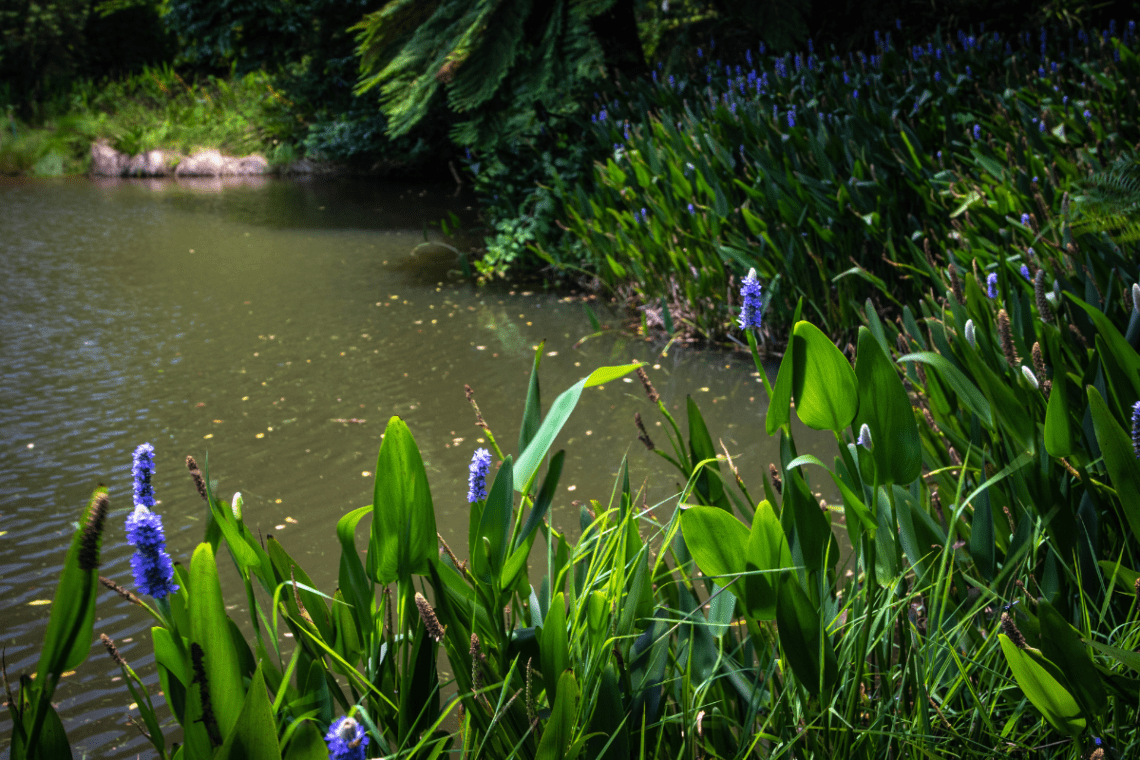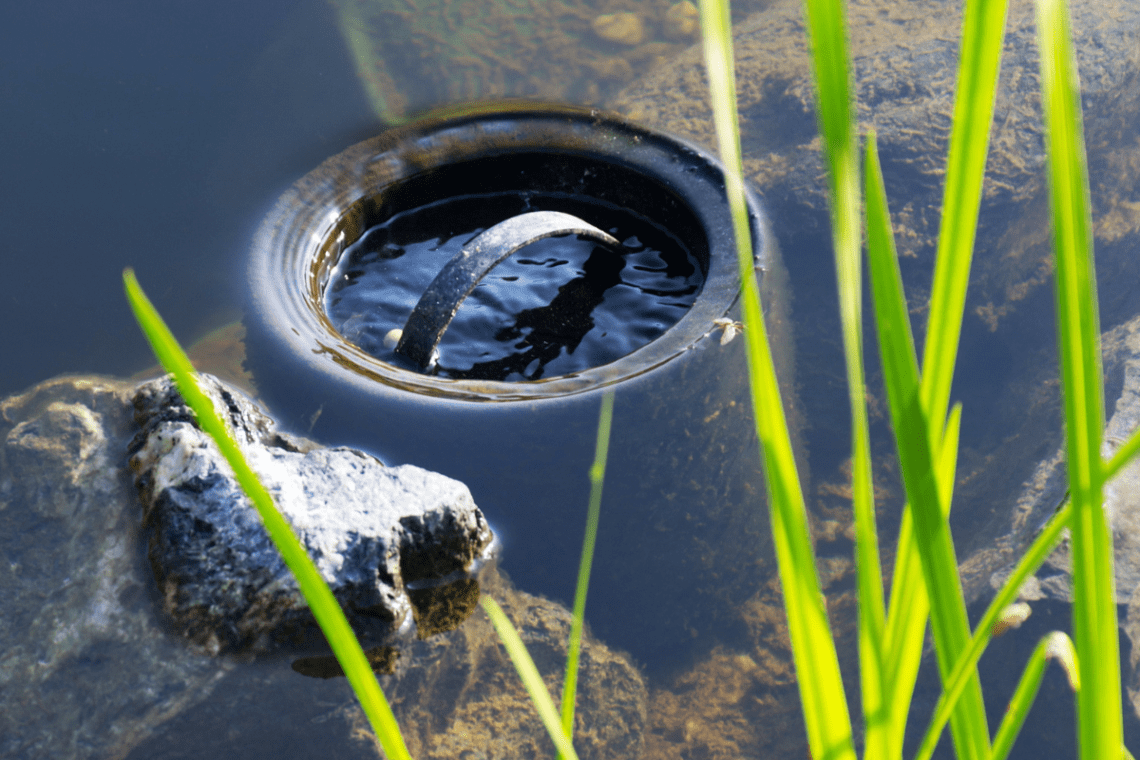New pond syndrome can be a frustrating challenge for new pond owners. This condition arises from a chemical imbalance in the water. It can lead to issues like green water, stress on your fish and unpleasant odours.
As your pond matures, you’ll need to focus on managing the nitrogen cycle. This involves converting ammonia into nitrite and then into less harmful nitrate. Adding aquatic plants can help balance water quality and improve fish health. However, this needs to be completed correctly as lots of plants have soil in them and this is where the ammonia comes from so you could be adding more to your water.
Maintaining a healthy pond ecosystem is vital. Regular water changes, testing for ammonia and nitrite levels and ensuring good aeration are crucial steps. When adding fish to your new pond, be mindful of not overstocking, which can lead to ammonia spikes and stress on your pond ecosystem. These small steps help prevent issues and encourage a thriving pond environment.
What is New Pond Syndrome?

New Pond Syndrome can be a challenge for pond owners, especially in newly constructed or filled ponds. It involves changes in water quality that affect fish and plants, often characterised by issues like high ammonia levels.
Characteristics of New Pond Syndrome
When a pond is new, it lacks the essential balance of bacteria needed to process fish waste. As you add fish, ammonia starts to accumulate from their waste and uneaten food. This can lead to green water as algae blooms thrive on these nutrients.
During this period, bacteria that convert ammonia into nitrite and then into less harmful nitrate have not yet fully developed. This nitrogen cycle is essential for a stable pond environment. Without it, ammonia and nitrite can spike to toxic levels, causing stress for fish.
Keeping a close eye on the water quality during the first few months and testing regularly is crucial. Ensuring that beneficial bacteria establish themselves on surfaces like filters, gravel and wet surfaces in the pond can help in moderating the nitrogen cycle effectively.
The Impact on Marine Life Health in Fish Ponds
New Pond Syndrome can significantly affect fish health. High levels of ammonia and nitrite create a toxic environment, leading to stress and health issues like nitrite poisoning. Koi keepers and those adding fish to new ponds should be cautious and monitor these levels closely.
Fish living in a pond with imbalanced water quality might show signs of stress, such as gasping for air at the surface, clamped fins or reduced activity. Regular water changes and the use of additives can prevent these problems.
6 Ways to Prevent New Pond Syndrome
Preventing New Pond Syndrome is crucial for maintaining a healthy pond environment. By managing chemical balances and supporting beneficial bacteria, you can keep fish healthy and water clear. Good practices like choosing the right filter media and using de-chlorinators also help maintain balance and avoid pond problems.
1. Balancing Nitrate and Nitrite Levels

In new ponds, keeping nitrate and nitrite levels balanced is essential. As the nitrogen cycle begins, fish waste generates ammonia, which is converted by nitrifying bacteria into nitrites and then into nitrates. High nitrite levels are toxic and can harm your fish, while nitrates are generally less harmful but can still stress fish if not managed.
To maintain these levels, introduce beneficial bacteria to help establish a healthy cycle. If nitrite levels become too high, a partial water change can help dilute them. Avoid adding too many fish initially, as this can increase ammonia and nitrite quickly, upsetting the balance.
2. The Significance of Aquatic Plants

Aquatic plants are vital for preventing New Pond Syndrome. They absorb excess nutrients from the water, reducing the likelihood of algae growth. Pond plants like water lilies add oxygen to the pond, which benefits both fish and beneficial bacteria. These plants also provide shade, which can help maintain stable temperatures in the pond.
Introduce enough plants to cover around a third of the pond’s surface. This can support a mature pond ecosystem as the plants draw on nutrients from fish waste and decomposing organic matter. During the pond’s initial stages, you may choose fast-growing plants that quickly consume nutrients, helping to prevent algae bloom and ammonia spikes.
3. Selecting the Right Filter Media

Choosing the right filter media is crucial for maintaining clean and balanced water. Filters help capture debris, reduce toxin levels and promote healthy bacterial growth on wet surfaces. Different media types target various pollutants; for example, biofilters enhance bacterial growth, while mechanical filters trap larger particles.
Consider using a combination of filter media to ensure comprehensive filtration. Regular maintenance, such as rinsing mechanical filters with pond water, keeps them effective without killing beneficial bacteria. Adjust the filter capacity according to your pond size and fish load to prevent issues like ammonia buildup and support a stable pond ecosystem.
4. Testing Your Pond Regularly

Regular water testing is important for catching undesirable changes before they cause harm. You should test for essentials like ammonia levels, nitrite, nitrate and pH regularly. Readily available test kits can give you a picture of your pond’s health, allowing you to act swiftly.
If required, use treatments to adjust pH levels or remove toxic substances. Choose treatments safe for fish such as koi and other pond-dwellers. Water changes can also be effective in managing poor water quality. Remain vigilant with testing, especially in ponds that are less stable, to prevent New Pond Syndrome.
5. Controlling Algae and Sludge

Algae and sludge can quickly become problematic if not managed. Algae blooms cause green water and block sunlight, while sludge harbours anaerobic bacteria that deplete oxygen. They can both lead to oxygen level drops, affecting fish health negatively.
Use algae treatments and physical removal methods, like skimmers, to control algae growth. Regularly remove sludge from the bottom of the pond with a pond vacuum or net. Adding oxygenating plants and ensuring proper aeration can also discourage excessive growth of algae and support aerobic bacteria over anaerobic bacteria, maintaining healthier water.
6. The Use of De-chlorinators

De-chlorinators are imperative when using tap water to fill your pond. Tap water commonly contains chlorine, which is toxic to fish and can destroy beneficial bacteria necessary for the nitrogen cycle. De-chlorinators neutralise chlorine, making water safe for fish and bacteria.
When adding water to the pond, apply de-chlorinators according to instructions for the amount being treated. Consider using them even for small water changes to avoid chlorine build-up. This practice ensures a safer environment for both koi and other aquatic life. By maintaining a chlorine-free pond, you foster a space where beneficial bacteria can thrive, supporting the overall health of your pond ecosystem.
How Ponds by Michael Wheat can Lessen New Pond Syndrome in Your Pond
As we’ve seen, New Pond Syndrome is going to happen in any swimming pond or pond. That said, by partnering with Ponds by Michael Wheat, we can shorten this due to our focus on water clarity and safety. In fact, we offer a Clear Water Guarantee to ensure your pond remains clear over the long term.
Through using the Michael Wheat System, we can help minimise New Pond Syndrome in your swimming pond, koi pond or wildlife pond. This works to tackle the long-term nitrogen cycle through phosphate and autotroph management.
If you’re interested in building a swimming pond in your garden or backyard, contact us today at 0116 2403735 or yourjourneybegins@pondandgardendesign.co.uk. We’ve built hundreds of ponds in the UK and look forward to hearing from you soon.